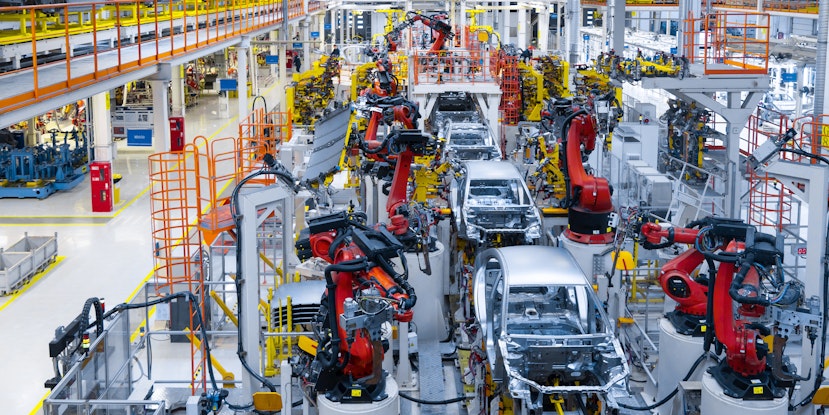How Many Jobs Are Available in Basic Industries? A Definitive Guide for 2025
Updated November 21, 2023
- What Are Basic Industries?
empty
empty
empty
empty
- What Is the Present Job Landscape in Basic Industries?
empty
empty
empty
- What Factors Influence Job Availability?
empty
empty
empty
empty
empty
- Strategies for Job Seekers Looking to Work in the Basic Industries
empty
empty
empty
empty
- Future Outlook for Jobs in Basic Industries in 2025
empty
empty
empty
- Frequently Asked Questions
- Final Thoughts
As of 2025, there are approximately 24,504,000 jobs available in basic industries in the United States, according to the Bureau of Labor Statistics.
This number is anticipated to grow by 2.7% by 2030. Basic industries encompass a wide range of careers dealing directly with raw materials, from metal fabrication to food science.
In this article, we’ll delve into the nuanced landscape of job availability within basic industries, unravel the complexities and unveil the essential role played by these industries in shaping the employment landscape.
We’ll also offer insights into the challenges and opportunities that define the employment landscape within basic industries and examine the role basic industries play in shaping the economic destiny of nations.
Let’s get started!
What Are Basic Industries?
Basic industries encompass the fundamental sectors that form the backbone of economic activity.
These include manufacturing, agriculture, energy and mining, each contributing indispensably to producing and distributing goods and services.
Integral to the supply chain, basic industries are the cornerstone upon which more intricate economic structures are built.
The basic industries in 2025 reflect a dynamic landscape where technological advancements, sustainability imperatives, and global economic shifts shape the future of manufacturing, agriculture, energy and mining.
Adaptability to change, environmental consciousness and strategic innovation are key themes guiding these industries into the next era.
Manufacturing
Manufacturing continues to be a linchpin of global economic activity in 2025.
Characterized by various sub-sectors, from automotive to electronics, the manufacturing industry remains a significant contributor to GDP and job creation.
Technological advancements, such as integrating Industry 4.0 principles, have transformed production processes, emphasizing automation, artificial intelligence and sustainable practices.
The sector is navigating challenges such as supply chain disruptions, workforce transformations and the imperative to adopt environmentally friendly practices.
Agriculture
Agriculture is an enduring pillar of basic industries, supplying the world with essential food and raw materials.
In 2025, the industry is witnessing a fusion of traditional practices with modern technologies, including precision farming, genetic engineering and sustainable agriculture initiatives.
Climate change poses challenges, leading to a heightened focus on resilient crops and adaptive farming methods.
The agriculture sector also plays a pivotal role in rural employment and food security, with an increasing emphasis on responsible and eco-friendly farming practices.
Energy
The energy sector in 2025 is undergoing a transformative phase, responding to the global demand for sustainable and clean energy sources.
Renewable energy, including solar, wind and hydropower, continues to gain prominence, driven by environmental concerns and technological advancements.
Traditional energy sources, such as oil and gas, are navigating a transition towards greener practices.
Energy security, grid modernization, and the development of energy-efficient technologies are central themes shaping the industry’s trajectory.
Mining
The mining sector remains a vital component of basic industries, supplying essential raw materials for various manufacturing processes. In 2025, the industry is adapting to increased environmental impact and sustainability scrutiny.
Technological innovations in mining practices, such as automation and digitalization, are improving efficiency while minimizing environmental footprints.
The sector also addresses social responsibility concerns by focusing on community engagement, ethical sourcing and responsible extraction practices.
What Is the Present Job Landscape in Basic Industries?
Understanding these facets of the job landscape in basic industries provides valuable insights for policymakers, businesses and individuals seeking employment or career advancement within these sectors.
It also highlights the need for targeted strategies to address regional disparities and foster sustainable growth in basic industries.
Current Employment Statistics
Basic industries collectively employ a substantial portion of the workforce, contributing significantly to global employment.
- Manufacturing – Employment statistics vary based on the manufacturing sub-sector, with industries like automotive, electronics and food processing each having distinct employment figures.
- Agriculture – The agricultural sector employs a large workforce, particularly in regions with extensive farming activities.
- Energy – Employment in the energy sector includes roles in renewable energy, traditional energy sources and energy services.
- Mining – Employment figures in mining are influenced by factors such as the demand for minerals and the level of mechanization.
Job Types and Roles
- Skilled Labor – Skilled workers in basic industries often include technicians, engineers, machine operators, and specialists in maintenance and quality control areas.
- Unskilled Labor – Unskilled labor encompasses roles such as general assembly line workers, farm laborers, and entry-level positions in mining and energy.
- Management – Basic industries require managerial roles for overseeing operations, including production managers, farm managers, energy project managers and mine supervisors.
- Administrative Positions – Administrative roles involve tasks such as planning, logistics, human resources and compliance within basic industries.
Technology integration is giving rise to new job roles, such as automation specialists, data analysts for precision farming, renewable energy technicians and sustainability experts.
Emerging roles also include positions focused on environmental compliance, safety protocols and digitization of processes.
Regional Disparities in Job Availability
Job availability in basic industries varies significantly across regions due to economic development, resource availability and government policies.
Developing regions may have a higher concentration of agriculture jobs and certain manufacturing types.
Energy jobs are influenced by the availability of renewable resources or traditional energy sources in a region.
Mining jobs are often concentrated in areas with rich mineral deposits, leading to regional disparities in employment.

What Factors Influence Job Availability?
Technological Advancements
The integration of automation and robotics in basic industries enhances efficiency and productivity.
Automation can lead to a decrease in routine, repetitive tasks. Still, it may simultaneously create a demand for skilled workers to operate and maintain automated systems.
Certain traditional jobs may be replaced by technology, leading to a shift in the skill set required in basic industries.
The rise of technology-intensive jobs, such as data analysts, robotics technicians and software developers, reflects the evolving nature of employment in these sectors.
Economic Policies and Regulations
Government policies and initiatives play a crucial role in shaping job availability. Incentives for businesses, subsidies and investment in infrastructure can stimulate job growth.
Training and education programs supported by government initiatives can help align the workforce with the evolving needs of basic industries.
Environmental and Labor Regulations
Stringent environmental regulations may influence the types of jobs available, pushing industries toward sustainable practices and creating demand for environmental compliance experts.
Labor regulations, including worker safety standards and fair employment practices, impact job conditions and the overall labor market within basic industries.
Market Demand and Supply
Shifting consumer preferences, such as a growing demand for sustainable products, influence job availability in industries adapting to these trends.
Emerging markets and changing demographics can create new opportunities, such as the demand for organic products in agriculture or renewable energy solutions.
Industry-Specific Factors
Sector-specific factors influence each basic industry. For example, global demand for specific products may influence manufacturing job availability.
Energy industries are affected by geopolitical events, resource availability and the development of new technologies.
Understanding these factors is crucial for individuals navigating the job market and businesses and policymakers shaping the economic landscape.
Adapting to technological changes, aligning with regulatory frameworks, and staying attuned to market demands are key strategies for ensuring sustainable job availability in basic industries.
Strategies for Job Seekers Looking to Work in the Basic Industries
By combining a strong educational foundation, relevant training, effective networking and a flexible skillset, job seekers can position themselves as competitive candidates in basic industries’ dynamic and evolving landscape.
Keeping a finger on the pulse of industry changes and proactively aligning skills with industry demands will contribute to long-term success in these sectors.
1. Educational Foundation
Pursue educational qualifications aligned with the specific needs of the basic industry you are interested in, such as degrees in engineering, agriculture, environmental science or relevant vocational training.
Acquire certifications that enhance your skills and make you stand out in the job market, such as certifications in advanced manufacturing techniques, sustainable agriculture practices or safety regulations.
2. Training Paths
Consider enrolling in vocational training programs that offer hands-on experience and practical skills relevant to the industry. These programs are often designed to meet the specific needs of employers in basic industries.
Vocational training can provide a quicker entry into the workforce. It may be particularly beneficial for roles that require specialized technical skills.
3. Networking and Industry Connections
Actively build and leverage a professional network within the basic industries you are targeting.
Attend industry conferences, trade shows and networking events to meet professionals and employers.
Join relevant online forums, social media groups and professional associations to stay updated on industry trends and connect with potential employers.
Seek mentorship from experienced professionals in the field to gain insights and advice.
4. Flexibility in Skillset
Basic industries are evolving, and employers value candidates who can adapt to change.
Showcase your adaptability through the following:
- Continuous learning – Stay updated on industry trends, technological advancements and regulatory changes through ongoing education and professional development.
- Diversify skills – Develop a broad skill set that includes both technical and soft skills. This can make you more versatile and valuable in a dynamic work environment.
- Highlight problem-solving abilities – Demonstrate your ability to adapt and find innovative solutions to challenges within the industry.
Future Outlook for Jobs in Basic Industries in 2025
The future outlook for jobs in basic industries in 2025 is dynamic, with a mix of opportunities and challenges.
Job seekers and industry professionals alike should stay attuned to these trends, proactively adapt their skill sets and embrace the ongoing transformations within these foundational sectors.
Anticipated Trends in Job Availability
1. Technological Integration
Anticipate an increased demand for skills related to technology and automation as basic industries continue to integrate advanced technologies into their processes.
Growth in jobs associated with data analysis, artificial intelligence and robotics may outpace traditional roles.
2. Sustainability Focus
Jobs related to sustainable practices and environmental compliance are likely to see growth as basic industries respond to global sustainability trends.
The push for eco-friendly manufacturing, energy efficiency and sustainable agriculture practices may create new job opportunities.
3. Skilled Labor Shortage
The demand for skilled labor may outstrip supply in certain industries, leading to increased competition for qualified candidates.
Specialized skills in areas like renewable energy technologies, precision farming and advanced manufacturing may be in high demand.
Potential Disruptions and Innovations
1. Automation Displacement
Increased automation may lead to displacement in certain traditional roles, requiring a focus on upskilling and reskilling to meet the demands of evolving job profiles.
Opportunities for innovation in designing, programming and maintaining automated systems may emerge.
2. Digitalization and Connectivity
The digitalization of basic industries may result in increased connectivity and the need for cybersecurity professionals to safeguard critical infrastructure.
Innovations in the Internet of Things (IoT) and smart technologies could reshape how industries operate, creating new job roles in these areas.
3. Green Jobs Expansion
The emphasis on sustainability may lead to the creation of new “green jobs” focused on renewable energy, sustainable agriculture, and eco-friendly manufacturing.
Innovations in clean energy technologies and carbon capture may open up new job opportunities.
Long-term Sustainability of Basic Industries
1. Environmental Stewardship
The long-term sustainability of basic industries hinges on their ability to adopt environmentally responsible practices.
Industries that prioritize eco-friendly processes and sustainable resource management are likely to thrive in the long term.
2. Workforce Development
Investments in workforce development, including education, training and ongoing skill enhancement, are essential for the sustainability of basic industries.
Collaboration between industry stakeholders, governments and educational institutions will play a crucial role in preparing the workforce for future challenges.
3. Global Economic Shifts
Basic industries are susceptible to global economic shifts, geopolitical events and changes in consumer behavior.
A focus on adaptability, diversification and resilience will be key for ensuring the long-term sustainability of basic industries in a rapidly changing global landscape.
Frequently Asked Questions
Basic industries include manufacturing, agriculture, energy and mining—foundational sectors crucial for economic development.
Companies like General Motors, Archer Daniels Midland, ExxonMobil, and BHP operate in manufacturing, agriculture, energy and mining, respectively.
Job availability varies, with millions employed globally. Refer to labor market reports for specific figures.
Safety varies by sector and employer. Adhering to protocols enhances workplace safety.
Basic sector employment involves foundational industries producing goods for both domestic and export markets, contributing significantly to economic stability.
Employment figures vary globally. Refer to national labor statistics for accurate data.
Accessibility depends on skills and education. Networking and staying informed enhance job-seeking success.
Final Thoughts
Understanding the job landscape in basic industries for 2025 is crucial for job seekers, policymakers and industry stakeholders.
With dynamic trends in technology, sustainability and market demand, opportunities and challenges emerge.
Navigating this landscape requires adaptability, continuous learning and strategic planning.
By embracing innovation, fostering sustainability, and aligning skills with industry needs, individuals can position themselves for success in the ever-evolving and foundational sectors of basic industries.




